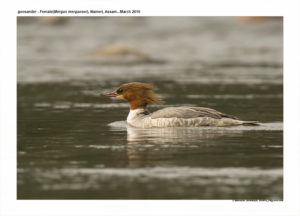Goosander-female

Goosander Mergus merganser
Etymology:
- Mergus : Latin word Water Bird
- Merganser : Latin word mergus- type of waterbird; anser – goose
Vernacular Name: Mar: Samanya Samudra Badak
Distribution in India: Breeds in Ladhak (Pangong Tso). Winters in North and Eastern India.
Description: Size of 58-72 cm. Male in breeding plumage has dark black-green head with rounded crest, white breast, belly and flanks, black primaries, and white secondaries and wing-coverts; bill red, serrated and with strong hooked tip, legs and feet reddish orange, and eyes brown; in eclipse plumage is much like female, but has darker crown, cinnamon head, shorter crest and boldly marked wings. Female has reddish-brown head with shaggy crest, white chin, and throat and on lores, pale greyish body, and blue-grey shoulder area.
Habitat: It is found in breeding season on clear, freshwater lakes, pools and in upper reaches of rivers, generally in vicinity of trees, in boreal forest and montane forest regions found also in deep-water lakes and fairly fast-flowing rivers. Winters on larger, unfrozen lakes and rivers, lagoons and brackish marshes.
Food Habits: It eats fish, aquatic invertebrates like molluscs, crustaceans, worms, insects and larvae, amphibians, small mammals and birds; very little plant material eaten. Ducklings mainly reliant on insects, changing to fish after 10–12 days. It feeds mostly by diving from surface, generally after scanning with head submerged, and even turning over small rocks to access prey; occasionally on surface and may upend. Prey generally swallowed only at surface, unless very small.
Breeding Habits: They breed in Ladhak during April- June. Seasonally monogamous and apparently not territorial, with males abandoning females early during incubation period, and pairs arrive on breeding grounds already paired or pair soon after. The females are strongly faithful to sites and exhibit natal philopatry. In single pairs or loose groups; nests in tree hole or other cavities (e.g. holes in banks among tree roots, cliff ledges, even roofs), sometimes on ground in dense cover or between loose boulders on islands, with only white down added, and generally sited close to water. The nest-site may be reused annually. Single-brooded. Lays a clutch of 8–12 eggs ,laid at one-day intervals. The incubation period is 30–32 days by female alone, commencing with final egg; chicks are precocial and leave nest within 24 hours of hatching. The fledging period is 60–70 days, tended by female alone but young abandoned prior to fledging, and continue to grow after achieving flight feathers.